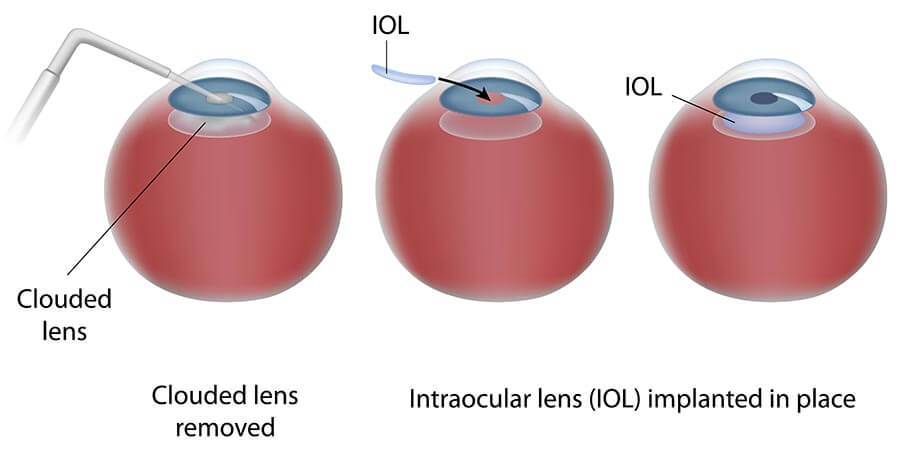What is a Cataract?
The eye works similar to a camera. Light enters the eye through the pupil, passes through a lens which focuses the images onto the retina at the back of the eye. The natural lens of the eye is clear. A cataract is clouding of the transparent lens of the eye. Changing your glasses prescription cannot fix this cloudiness of the lens so even when you have the best possible glasses prescription, your vision appears blurry. Cataracts are the most common cause of blurred vision in those over the age of 50.
What causes cataracts?
The majority of the time, cataracts are a natural part of the aging process. They do not occur at the same time in everyone, just like any other age related changes. Occasionally, cataracts can form for other reasons. These include injury, diabetes, use of certain medications, birth defects, or from previous surgery of the eye.
How do I know if I may have a cataract?
Cataracts cause alterations in your vision. They do not cause pain, tearing, redness of your eyes, or irritation. They typically cause blurriness, haze, and/or increased problems with glare. Vision may be affected over a period of years or it may be months. Normally, the natural lens of the eye sits within the eye itself, so cataracts are diagnosed by your eye doctor when they examine your eye at the slit lamp, a special microscope for examining the eye. Cataracts do not cause pain and most often develop slowly over time, gradually blurring your vision. You may not notice this decrease in vision at first, but it will become increasingly evident when trying to do daily activities.
When should I have my cataracts removed?
The decision of when is the right time to remove your cataract varies from one person to the next. It is an elective cataract surgery, so because the cataract is not harmful to your eye in the vast majority of cases, nothing needs to be done unless you are noticing the effect of the cataract on your vision. Once a cataract begins to affect your activities of daily living, whether it be during reading, driving, work activities, or participating in one’s hobbies, then cataract surgery is a sensible option. The notion that a cataract must become “ripe” prior to surgery is somewhat of an idea of the past. With modern day techniques and advances, there is no reason to delay one’s surgery if it can improve your vision and thereby improve your quality of life.
How are cataracts removed?
Since the cataract is located within your eye, removal of the cataract requires surgery; it cannot be treated with laser or medicine. It is one of the most common and most successful surgeries performed in this country. All of our New Hampshire Ophthalmologists at Eyesight perform cataract surgery. If you are experiencing symptoms of cataract formation, schedule a complete eye examination with one of our Ophthalmologists who can discuss your condition and treatment options with you.
How does cataract surgery work?
The goal of cataract surgery is to remove the cloudy lens and replace it with a clear artificial lens implant to restore your vision. Cataract surgery is performed on an outpatient basis in a hospital or surgery center. Depending on the case, patients are given a local anesthetic as well as a light sedation to make them feel relaxed during the surgery. Ultrasound is used to break up the cloudy lens (cataract) into tiny pieces which are removed through a small incision. An artificial lens is used to replace the cataract. This artificial lens is specifically selected based on the characteristics of the patient’s eye so that it will direct the light onto the retina at the back of the eye. Typically, the procedure takes less than 30 minutes. Patients return home the same day and can resume their usual activities within a few days. Your New Hampshire cataract surgeon will explain this entire process prior to surgery and provide all of the after surgery details necessary for a healthy recovery.
Special lenses
There has never been a better time to have cataract surgery. There are now advancements in lens technologies available which can allow patients to see clearly at multiple distances. These are called Multifocal Lenses and often times reduce the need for reading glasses.
There are also special lenses for people with significant astigmatism. This helps patients with corneal astigmatism achieve the sharpest vision after cataract surgery and may eliminate the need for glasses to correct any residual astigmatism after surgery. Our New Hampshire Cataract Surgeons will be happy to discuss special lenses and what they can do to help your vision after cataract surgery.
Questions about Cataract Eye Surgery
The following information answers questions that we frequently hear from our patients about cataract eye surgery. For more information, please contact our New Hampshire cataract surgeons.


